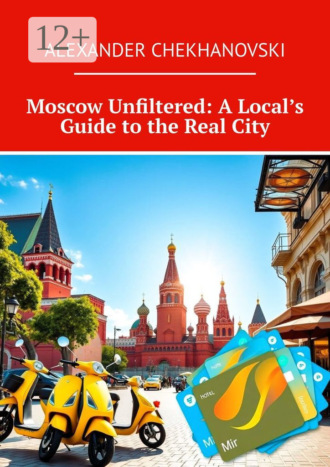
Полная версия
Moscow Unfiltered: A Local’s Guide to the Real City
Inspectors: Fare inspectors in uniform regularly board vehicles to check tickets. They will present official identification and a badge. Riding without a valid ticket can result in a fine of 2,000 rubles. Increased Fine: If the fine is not paid within two months, it may be increased to 4,000 rubles.
Air Conditioning Issues: During the sweltering summer months, air conditioning in some older buses may be inadequate or even non-functional. Beat the Heat: If you’re traveling during a heatwave, consider opting for the metro (which is generally well-air-conditioned) or newer buses/trams that are more likely to have working AC. Hydration: Always carry water with you, especially if you are travelling during warmer months.
Important Note: It’s worth emphasizing that these potential drawbacks are not always the norm. Moscow’s public transport is generally reliable, affordable, and convenient. However, being aware of these possibilities allows you to plan your journeys strategically and avoid unnecessary stress.
II. Metro (Subway)
The Moscow Metro: Without a doubt, the most efficient and convenient way to travel around Moscow. The Moscow Metro is one of the largest and most impressive metro systems in the world, with a vast network of lines that can take you to almost all parts of the city. The stations are clean and well-maintained, and many are decorated with beautiful mosaics, sculptures, and architecture. This is a must-see for all visitors to Moscow. Navigating the Metro: The metro can seem daunting at first, but it is easy to use once you have learned the basic system. Each line is marked with a specific color, and the stations are clearly named in Russian, and English. The system is logical, and very easy to navigate.
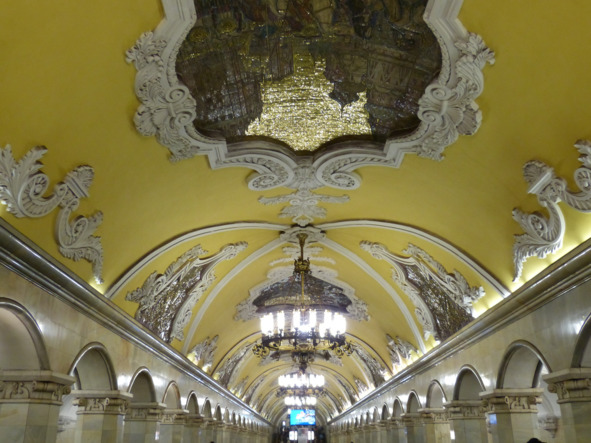
The Moscow Metro
Metro App: The Moscow Metro app (available for both Android and iOS) is an invaluable resource. It provides maps, routes, travel times, and ticket information. It also provides up-to-date information about any delays, or other issues on the network. Download the app before you travel: ([Links to be inserted once verified, to ensure that they are accurate, and updated for 2025]). Ticket Options: You can purchase a “Troika” travel card, which is rechargeable, or single tickets for single journeys. If you plan to use the Metro frequently, it is worth getting a Troika card, as it will reduce the cost of your travel.
Station Highlights: The Metro itself is an important tourist destination, with several historic and beautifully decorated stations. Be sure to visit some of the most famous stations like Mayakovskaya, Ploschad Revolyutsii, Komsomolskaya, and Kiyevskaya. Safety: The Metro is generally very safe, even at night. Like any public space, it is always advisable to be aware of your surroundings, and your belongings. The Metro is well-lit, well-patrolled, and generally very secure. Buses, Trams, Taxis, and Ride-Sharing (Yandex Go).
Buses and Trams: Buses and trams are useful for reaching areas not directly served by the Metro. The services are reliable, but they can be affected by traffic conditions. It is useful to use a mapping app, or the Citymapper app to plan your route: ([Links to be inserted once verified, to ensure that they are accurate, and updated for 2025]). Yandex Go: Yandex Go is the most popular ride-sharing app in Moscow. It can be used for a range of taxi, and ride-sharing options. You may need a Russian SIM card to use it, but it is a convenient, and reliable way to travel. Check the Yandex Go website and app for details: ([Links to be inserted once verified, to ensure that they are accurate, and updated for 2025]).
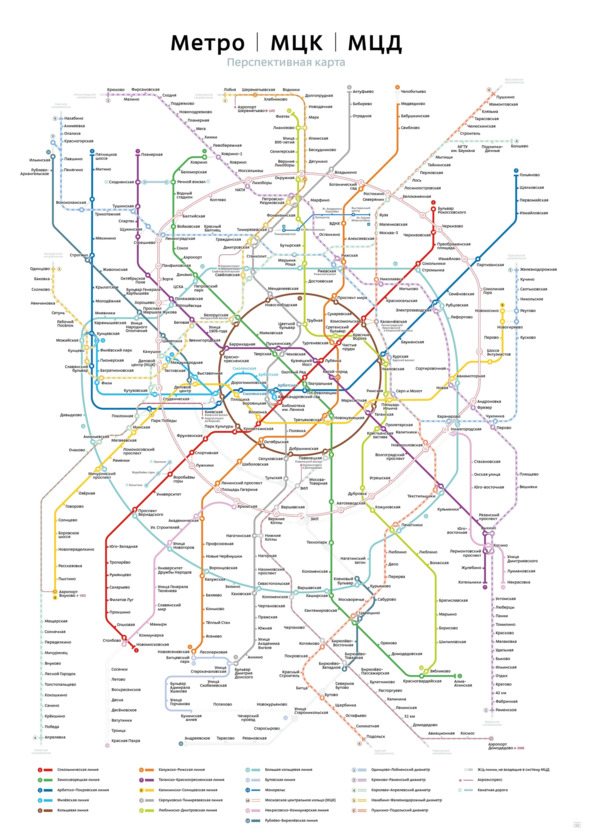
Moscow metro map 2025
The Moscow Metro is the backbone of the city’s transportation system, with a vast network of lines covering most of the city. It is efficient, relatively cheap, and fast. Routes: The metro has 14 lines, each identified by a number and a color. The lines connect most parts of the city and its suburbs. Operating Hours: Generally, the metro operates from around 5:30 AM to 1:00 AM daily, with some slight variations on different lines. Frequency: Trains run frequently, with intervals of around 1—3 minutes during peak hours. Navigation: The metro system is easy to navigate, with signs in both Russian and English. You can also use mobile apps for navigation.
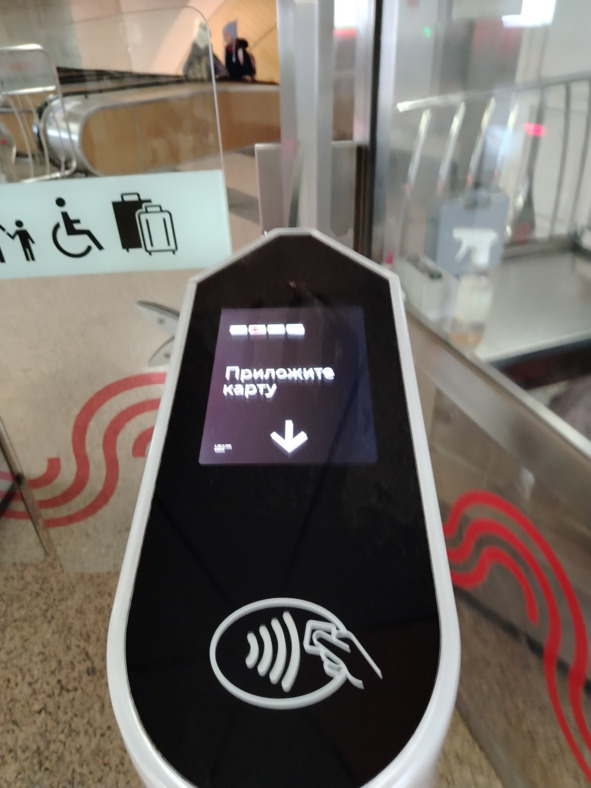
Metro turnstile
Moscow Central Circle (MCC): The MCC is an orbital railway line that connects with many metro stations, providing a convenient way to travel around the city and to access different areas of the city and region. Routes: The MCC runs in a circle, with interchange stations to different metro lines. Operating Hours: Operates from around 5:30 AM to 1:00 AM, similar to the metro. Ticketing: The same Troika card used for the metro can also be used on the MCC. Frequency: Trains run every 5—10 minutes during peak hours.
Moscow Central Diameters (MCD): The MCD is a system of railway lines that connect Moscow with its surrounding regions. It is useful for longer trips, including airport transfers and trips to the suburbs. Routes: There are several MCD lines connecting the city and the surrounding region. Operating Hours: Trains generally run from around 5:30 AM to 1:00 AM. Ticketing: The Troika card is also valid on MCD lines, and you may be able to use contactless bank card payments in some cases. Frequency: Train frequency varies between routes but is usually frequent at peak times.
** наземный транспорт (Trams, Buses, and Electric Buses):**
Moscow has an extensive network of surface transport, including trams, buses and electric buses. They connect all parts of the city, especially those areas which are less served by the metro. Routes: The routes are marked with numbers and are available on public transport apps and route planning tools. Operating Hours: These modes of transport generally operate from 5:00 AM to 1:00 AM daily, but check specific route times when planning a journey. Ticketing: The Troika card is valid for all these modes of transport. Frequency: Bus and tram frequencies vary, and can be more affected by traffic than the metro. Electric Buses: Moscow is actively switching to electric buses, which are more environmentally friendly than traditional buses.
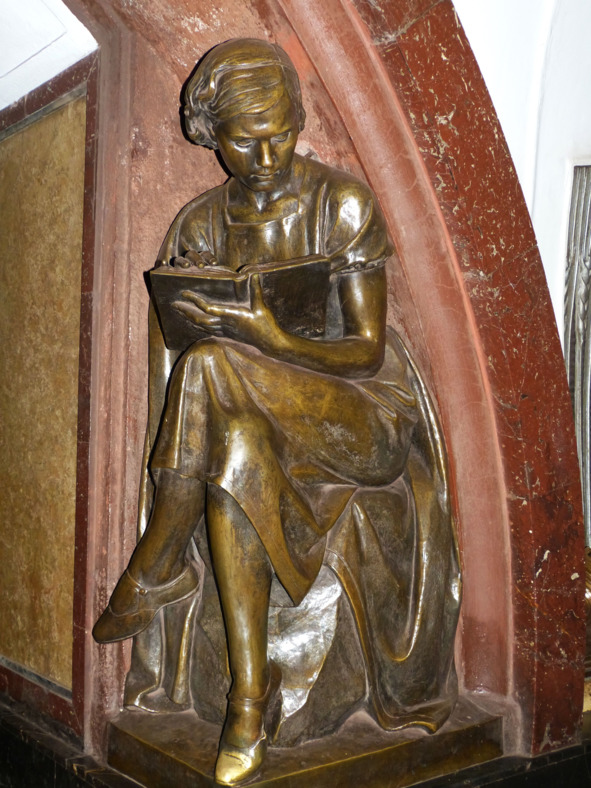
Navigating Moscow’s Metro During Rush Hour:
Peak Times to Avoid: The Moscow Metro is an efficient and stunning way to get around, but it can become extremely crowded during rush hour, when people are commuting to and from work. It is best to avoid the metro during these hours. Morning Rush: 7:30 AM to 9:30 AM
Evening Rush: 5:00 PM to 7:00 PM
Lines to Be Especially Cautious Of: The Circle Line (Koltsevaya Line): This line connects all the radial lines and is particularly congested during peak hours. Major Transfer Stations: Stations where multiple lines converge (e.g., Komsomolskaya, Kiyevskaya, Park Kultury) will be the most crowded. Why Avoid Rush Hour?
Difficulty Boarding: It can be challenging to board trains, especially with luggage. Pickpockets: Crowded conditions increase the risk of petty theft. Discomfort: The sheer volume of people can be overwhelming. Alternative Times: If possible, travel during off-peak hours to enjoy a more comfortable and less stressful experience.
III. Navigating Moscow by River: An Introduction to River Trams
Moscow, a city defined by the majestic Moskva River, offers a unique and scenic transportation option: the river tram. These river buses and boats provide not only a means of getting around but also a wonderful way to experience the city from a different perspective, enjoying breathtaking views of Moscow’s landmarks.
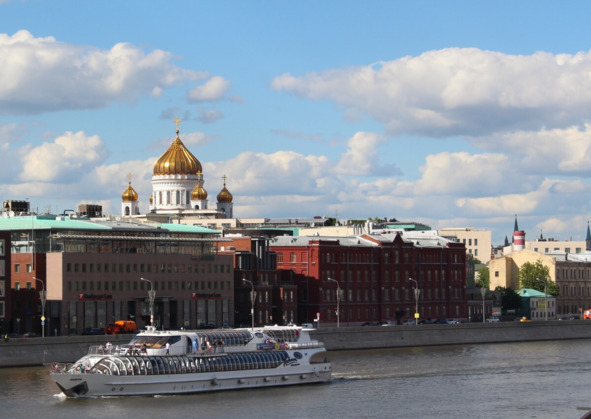
A Unique Mode of Transportation:
Unlike the bustling streets and crowded metro, river trams offer a tranquil and relaxing way to navigate the city. They provide a break from the urban hustle, allowing you to enjoy the fresh air and the views of the city from the water. They’re especially enjoyable during the warmer months.
Benefits of Using River Trams:
Scenic Views: See Moscow’s landmarks from a unique vantage point on the river. Relaxing Journey: Enjoy a peaceful and relaxing way to travel, away from the traffic and noise of the city. Unique Experience: A memorable way to experience Moscow that goes beyond typical tourist routes. Access to Riverside Attractions: Reach many riverside parks, monuments, and attractions directly. Alternative Commute: In some cases, they serve as a practical option for commuting. Photo Opportunities: Capture stunning photos of the city’s skyline and riverside views.
Ticket Information:
River tram tickets can be purchased online, at the piers, or sometimes directly onboard. The prices vary based on the operator, route, and time of day.
Standard Tickets: Generally, tickets for a single route or a specific time period are available. Day Passes: Some operators offer day passes for unlimited travel on their routes. Combined Tickets: Sometimes combined tickets are offered for several excursions and river tram rides. Discounts: Check for possible discounts for children, seniors, or groups. Online Purchases: Buying tickets online in advance is advisable, especially during peak season. “Troika” Card: Note that sometimes public transport “Troika” travel card is not valid on commercial river tram lines and those have to be paid separately. Check before boarding.
Popular Routes:
The Moscow River has several routes, each offering a different perspective of the city. Here are a few notable routes:
Central Route: This route typically connects key points in the city center, offering views of the Kremlin, St. Basil’s Cathedral, and other central landmarks. Park Routes: Some routes take you further from the center, passing by the parks on the Moskva River, such as Gorky Park or Kolomenskoye. River Ring Route: Some river tours follow a circular path around Moscow center.
Common Piers (Stops):
The river trams stop at various piers along the Moskva River. Here are some of the most notable ones:
Gorky Park Pier: A popular pier near the main entrance of Gorky Park. Kievsky Pier: Located near the Kievsky Railway Station, a central location on the river. Novospassky Most Pier: Located near the Novospassky Monastery, a historic area of Moscow. Vorobyovy Gory Pier: Near the Sparrow Hills, offering great views of the city. Zaryadye Park Pier: Located close to the Zaryadye Park, near the Kremlin. Krasnopresnenskaya Pier: A popular pier near the Moscow City business district. Pushkinskaya Embankment Pier: Close to Gorky Park, offering access to recreational areas.
Note: Specific piers and routes may vary depending on the operator. It’s always best to check the specific operator’s website for the most accurate information.
Types of River Trams (Riverboats):
River trams come in various types, including:
“Radisson” Riverboats: Radisson Royal Flotilla offers modern and comfortable boats, sometimes with dining options. They are more premium priced. “Capital Shipping Company” Boats: This company uses various types of modern river trams, including those with open decks. “Riverbus” Boats: Offer smaller river buses mainly for commuting with fixed stops. “Moscow River” Boats: Operated by various companies, using different types of small riverboats. “Meteor” Hydrofoil: These are older, higher-speed options, but not often used today and are found for longer routes outside of Moscow
Note: These names may vary based on the operator, but these are some common examples.
History of River Transportation in Moscow:
River transport has been an integral part of Moscow’s history for centuries. Originally used for cargo and trade, the river was later developed for passenger transport. River trams, as a formal means of transportation, gained popularity in the Soviet era as a more relaxed and enjoyable alternative to crowded city buses. Today, they blend traditional transport with modern amenities and tourist appeal, offering a glimpse into the history of the city, while being a modern and enjoyable way to travel.
Tips for Planning Your River Tram Ride:
Check the Schedule: Confirm the schedule and routes, as they can vary seasonally and by operator. Arrive Early: Particularly during peak season, arrive at the pier a little early to avoid lines. Bring a Camera: Capture the stunning views of the city from the water. Check Weather: Dress appropriately for the weather, as it can get breezy on the river. Bring Snacks and Water: Although some boats may have onboard catering, it can be useful to have your own. Be Aware of the Return Trip: Make sure you are aware of the last service back so you are not stranded or delayed.
River trams in Moscow offer a unique and memorable experience, allowing you to see the city from a different perspective. Whether you use them for commuting or leisurely sightseeing, river trams are a must-try for anyone visiting Moscow. Their combination of history, beautiful views, and modern functionality makes them a valuable and enjoyable aspect of the city’s transportation network.
IV. Troika Card
The Troika card is the most convenient way to pay for all forms of public transportation in Moscow. It can be purchased and topped up at metro station ticket offices and machines, as well as at some other points across the city. Single Trip Ticket: A single trip ticket can be purchased at ticket offices and machines. However, it is generally more expensive than using the Troika card. 90-Minute Ticket: This allows unlimited travel on buses, trams, trolleybuses, and the metro within 90 minutes. It is also available on the Troika card. Day Passes: Options for 1-day, 3-day, and 30-day unlimited travel are available. They can be loaded onto the Troika card. Contactless Payment: Contactless bank cards and smartphones with NFC can also be used to pay on the metro, MCC and MCD. However, they are not always accepted on other modes of transport. Fare Prices: Fares vary depending on the type of ticket, and the mode of transport. The fares can change so it is best to check the official transport website for accurate prices. A single trip using the Troika card is usually cheaper than a single paper ticket. Day passes are generally economical for those planning multiple journeys in a single day.
Purchasing Tickets: Troika cards can be bought and topped up at ticket offices and machines at metro stations. Some other locations also sell tickets, but metro stations are the most convenient.
Useful Links: Official Website of Moscow Transport: https://www.mos.ru/en/transport/
Moscow Metro Website: https://www.mosmetro.ru/en/ Tutu.ru (Transport Fares Information): https://www.tutu.ru/2read/articles/moscow_fares/
Other Transportation Methods
Taxis: Taxis are widely available throughout Moscow, and are best booked through a mobile app, such as Yandex Taxi. Car Sharing: Car sharing services are available but require local registration. Cycling: Moscow is becoming more cycle friendly, with cycle lanes and bike rental schemes in some areas.
Taxis: Taxis are also widely available, but it is always best to confirm the price before starting the journey, to avoid issues. Moscow Central Circle (MCC): The MCC is a circular railway line that integrates with the Metro, providing connections to other areas of the city. The MCC is a good option for reaching places that are further away from the center, and it can help you to avoid delays on the roads. Use the Moscow Metro App to plan your route: ([Links to be inserted once verified, to ensure that they are accurate, and updated for 2025]).
Payment Options: You can pay for public transportation with bank cards, or via contactless payments, or with cash. The Troika card is a good option, and it is rechargeable. You can pay for taxis, and Yandex Go via cash or contactless payments.
Accommodation in Moscow: Moscow offers a wide range of accommodation options, catering to all budgets and preferences. From luxurious hotels to budget-friendly hostels, and apartments for longer stays, there are a range of choices to suit your needs: Luxury Hotels: Moscow is home to many international luxury hotel brands, offering high-end services, stylish interiors, and central locations. These hotels often offer a range of services including restaurants, bars, spas, and other facilities. Expect to pay premium prices for this level of comfort, and service. Examples include The Ritz-Carlton, Four Seasons, and Hotel National. Be sure to check online travel sites for recommendations, and reviews. Mid-Range Hotels: Mid-range hotels offer a good balance of comfort, convenience, and price, and provide a great way to experience the city, without the premium costs of luxury hotels. These hotels provide a comfortable stay, with good facilities, often including a restaurant, bar, and internet access. Many of the chains are reliable and popular. You can find excellent options in most areas of the city. Be sure to check online reviews before making a booking. Budget Hotels and Hostels: Budget hotels and hostels are a great option for travelers on a tight budget. These offer a basic room or dorm bed for very reasonable prices. The quality can vary greatly, so it is essential to check online reviews, before you make a booking. They are a great option for those who want a simple, budget friendly stay, and don’t require lots of facilities. Many are located close to metro stations, and other areas of interest. Apartment Rentals: Renting an apartment is a good option for longer stays, or for those who prefer a more home-like environment, with full facilities. There are a range of apartments to rent on most of the major booking sites, including AirBnB. This can often be a more affordable option, and gives you the chance to experience a local environment. Be sure to check online reviews, and use a reliable booking platform. Booking Platforms: Use reputable booking sites, such as Booking.com, Expedia, Agoda, or AirBnB, to browse your options. Always check the location, facilities, prices, and reviews, before you make a booking. Location Tips: If possible, book accommodation that is close to a metro station, and convenient to the places you wish to visit. The best locations will depend on your individual needs, so look for recommendations from travel websites, and guide books. Book in Advance: Book your accommodation in advance, especially if you are travelling in peak season. The most popular locations, and the most popular accommodation options often book up well in advance. Booking ahead is essential to avoid disappointment. Budgeting for Your Trip: Moscow can be an expensive city, but you can visit on any budget with some careful planning, and good budgeting skills.
4. Electric Transportation in Moscow: A Comprehensive Guide to E-Scooters (2025)
Moscow has embraced e-scooters as a key mode of urban transport. This section offers a detailed look at the rental landscape, practical tips, and safety advice for navigating Moscow on two wheels in 2025.
I. Major E-Scooter Rental Companies in 2025 (Examples and Features)
While the market is dynamic, we can anticipate several major players being active in Moscow in 2025, possibly including:
Whoosh: Likely to remain a major player. Known for its widespread coverage, user-friendly app, and generally modern scooter models. Features include: Geofencing: Automatic speed reductions in pedestrian areas and restrictions in areas where parking is forbidden. “No-Parking” Zones: Clearly marked no-parking zones in the app, with fines for improper parking. Battery Levels: Real-time battery level display in the app, helping users to avoid running out of charge mid-ride. Insurance: Some level of built-in accident insurance. Subscription Options: Daily and weekly subscription options for cost savings. Yandex Go (with Scooters): Yandex, a local technology giant, will likely offer integration with their other transportation services. Features might include: Integrated Payment: Seamless payment through the Yandex Go app, if the user is already familiar with other Yandex services. Route Planning: Integration with Yandex Maps for optimal route planning. Multiple Vehicle Types: Possibility to rent other types of micromobility options along with scooters, e.g. bicycles. Other Potential Players: Be prepared for the possibility of other companies, perhaps with an international background, joining or growing in the market by 2025.
E-Scooter Models (2025 Expectations):
Expect models with the following specs (subject to manufacturer differences):
Electric Motor: 350—500W brushless hub motors with high torque for hill climbing. Battery: Lithium-ion batteries offering 30—50km range on a single charge. Battery capacity should improve, so that models with even greater range could be available. Top Speed: Typically capped at 20—25 km/h by law in many areas of the city, with slower speeds enforced in pedestrian zones (geofencing). Tires: Puncture-resistant tubeless pneumatic tires, around 8—10 inches for good grip and comfort, with a move towards larger tire sizes for a more comfortable ride. Brakes: Front and rear electric brakes and possibly disc brakes for better stopping power. Display: Integrated LCD display showing speed, battery level, and ride mode. Lights: Bright front and rear LED lights for better visibility, with turn signals likely becoming more common. Weight: Expecting scooter weight to remain under 20kg for easier maneuverability and carrying, with models using lighter materials like magnesium alloy becoming more common. Connectivity: Bluetooth and GPS for app control, ride tracking, and geofencing.
II. How to Rent an E-Scooter (Step-by-Step Guide)
Download the App: Download the official app for your chosen rental provider from your device’s app store. Create an Account: Register using your phone number and email. You may need to provide a payment method (credit/debit card). Locate a Scooter: Use the app’s map to locate the nearest available scooter. Unlock the Scooter: Scan the QR code on the scooter using the app to unlock it. Start Your Ride: Put on your helmet, get on the scooter and push off to begin your ride. Ride Safely: Follow traffic rules, stay in designated lanes, and mind your speed, especially in pedestrian areas. End Your Ride: Park the scooter in a designated parking zone shown in the app. End the ride within the app to finalize the rental. Payment: Payment is automatically processed through your registered payment method.
Typical Costs & Payment Systems (2025):
Unlock Fee: 30—50 rubles (subject to change and promotions). Per-Minute Fee: 3—7 rubles per minute. Could depend on the day of the week and time of the day. Subscription Options: Daily/weekly passes with rates that vary, but are often more economical for frequent users. Payment Methods: Expect major debit/credit cards, mobile payment systems (like Apple Pay or OpenAI Pay), and sometimes local payment systems.
III. Safety Rules & Regulations
Traffic Rules: Treat the e-scooter as a bicycle. Follow all applicable traffic laws, use bicycle lanes when available, and stop at red lights. Speed Limits: Pay attention to posted speed limits on your app, usually around 20—25km/h. Automatic speed reduction may be enabled by geofencing in busy areas. Sidewalk Riding: Avoid riding on sidewalks in most areas. Helmet Use: While not always legally required, wearing a helmet is highly recommended. Alcohol Consumption: Never ride an e-scooter while under the influence of alcohol or drugs. Proper Parking: Park only in designated parking zones. Improper parking can result in a fine. Passenger Restrictions: Only one person is allowed per scooter.


